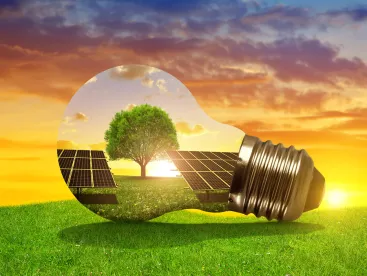Biden Administration Announces Initiatives for Offshore Wind
On March 29, National Climate Advisor Gina McCarthy, Interior Secretary Deb Haaland, Energy Secretary Jennifer Granholm, Commerce Secretary Gina Raimondo, and Transportation Secretary Pete Buttigieg met with state officials, industry executives, and labor leaders to announce new leasing, funding, and goals to accelerate and deploy 30 gigawatts of offshore wind by 2030. According to the Department of Energy, this would support 45,000 jobs, generate enough electricity to power over 10 million American homes, and avoid 78 million metric tons of carbon dioxide emissions. The Administration also announced a new Wind Energy Area between Long Island and the New Jersey coast, a Notice of Intent (NOI) to prepare an Environmental Impact Statement (EIS) for Ocean Wind, a Notice of Funding Opportunity for port authorities and other applicants to apply for $230 million for port and intermodal infrastructure-related projects through the Port Infrastructure Development Program, the award of $8 million to 15 offshore wind research and development projects that were selected through a competitive process, a fact sheet to facilitate access for the offshore wind industry for $3 billion in funding through the Innovative Energy Loan Guarantee Program, a Memorandum of Agreement with offshore wind development company Ørsted to share physical and biological data in Ørsted-leased waters subject to U.S. jurisdiction, and a request for research proposals to support more than $1 million in grant funding to improve understanding of offshore renewable energy for the benefit of a diversity of stakeholders including fishing and coastal communities.
Read more from the White House by clicking HERE.
Solar Energy Gets Boost from DOE
In support of President Biden’s goal of a 100% clean electricity grid by 2035, the Department of Energy has announced a new target to cut the cost of solar energy by 60% within the next ten years, in addition to nearly $128 million in funding to lower costs, improve performance, and speed the deployment of solar energy technologies. DOE is accelerating its utility-scale solar 2030 cost target by five years – setting a new goal of driving down the current cost of 4.6 cents per kilowatt-hour (kWh) to 3 cents/kWh by 2025 and 2 cents/kWh by 2030. New funding supports two materials used to make solar cells: perovskites and cadmium telluride (CdTe) thin films, and includes $40 million for perovskite R&D, $3 million for a new Perovskite Startup Prize, $20 million CdTe thin films, $7 million for projects to increase the lifetime of silicon-based PV systems, $33 million for concentrating solar-thermal power (CSP) advances, and $25 million to demonstrate a next-generation CSP plant.
Additional background, including funding opportunity information, can be found HERE.
White House Announces Environmental Justice Advisory Council Members
In support of President Biden’s Executive Order on “Tackling the Climate Crisis at Home and Abroad”, the White House has announced the members of the White House Environmental Justice Advisory Council (WHEJAC) who will provide advice and recommendations to the Chair of the Council on Environmental Quality (CEQ) and the White House Environmental Justice Interagency Council on how to current and historic environmental injustices. With backing and administrative support provided by the Environmental Protection Agency, WHEJAC will complement the ongoing work of the National Environmental Justice Advisory Council (NEJAC), a federal advisory committee established in 1993 to provide advice and recommendations on environmental justice issues to the Administrator of the EPA.
For the full list of members, click HERE.
President Biden Invites World Leaders to April Climate Summit
Forty world leaders have been invited by President Biden to attend his “Leaders Summit on Climate” scheduled for April 22 and 23 ahead of the United Nations Climate Change Conference (COP26) this November in Glasgow. According to the White House, “The Summit will reconvene the U.S.-led Major Economies Forum on Energy and Climate, which brings together 17 countries responsible for approximately 80 percent of global emissions and global GDP. The President also invited the heads of other countries that are demonstrating strong climate leadership, are especially vulnerable to climate impacts, or are charting innovative pathways to a net-zero economy. A small number of business and civil society leaders will also participate in the Summit.”
Click HERE to read more, including the list of invited leaders.
New Senate Carbon Capture Legislation
Sens. Smith (D-MN) and Capito (R-WV) have introduced the Carbon Capture Utilization and Storage Tax Credit Amendments Act. The bipartisan legislation would extend “commence construction” by five years, allow for direct payment of carbon capture credits, increase support for direct air capture of CO2 from the atmosphere, allow the 45Q credit to offset tax obligations due to the Base Erosion Avoidance Tax (BEAT), and revise the 48A tax credit to make it work for CCUS retrofits.
To read more, including a bill summary and legislative text, click HERE.
Climate Change Education Act Reintroduced in House & Senate
Sen. Markey (D-MA), Rep. Dingell (D-MI) and Rep. Brownley (D-CA), have reintroduced the Climate Change Education Act, which would create a grant program at the National Oceanic and Atmospheric Administration (NOAA) to assist state and local education agencies improve climate literacy, as well as institutions of higher education and professional associations. The legislation is intended to ensure that students at all age levels are taught about climate adaptation and mitigation; climate resilience; and the effects of climate change on the environment, energy sources, and social and economic systems, including environmental and climate justice. The bill would support professional development for teachers; science, technology, health and engineering education; the development of climate literacy curricula; and improve the quality of and access to training and certification for jobs that incorporate climate mitigation. The Climate Change Education Act authorizes $50 million a year from 2021 through 2026 to be appropriated to NOAA to establish the Climate Education program office and administer the grant program.




 />i
/>i

